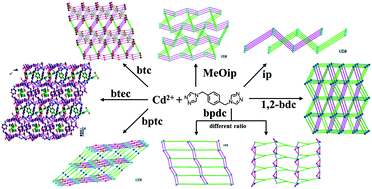A series of Cd(ii) coordination polymers based on flexible bis(triazole) and multicarboxylate ligands: topological diversity, entanglement and properties†
Abstract
Eight Cd(II) coordination polymers, {[Cd(btrb)(H2O)4][Cd2(btrb)(btec)(H2O)2]2(OH)2·5H2O}n (1·(OH)2·5H2O), {[Cd(btrb)0.5(bptc)0.5]·H2O}n (2·H2O), {[Cd3(btrb)(btc)2]·3H2O}n (3·3H2O), {[Cd(btrb)(ip)(H2O)]·H2O}n (4), {[Cd(btrb)(MeOip)]·H2O}n (5), {[Cd2(btrb)2(1,2-bdc)2]·3H2O}n (6), {[Cd2(btrb)(bpdc)2]2·11H2O}n (7) and {[Cd(btrb)(bpdc)]·H2O}n (8), were synthesized under hydrothermal conditions. 1 shows an unprecedented (4,4,4,4)-connected 3D (electroneutral motif) + 1D (cationic motif) → 3D polythreaded structure. The point symbol of the new 3D motif is (46)2(86)(42·82·102)(43·83)4, or the second mot topology based on the [Cd2(COO)] dimer. 2 shows an unprecedented (4,5,6)-connected 3D network with a point symbol of (42·84)(47·63)2(46·66·83). 3 shows an unprecedented (3,8)-connected self-catenated 3D network based on the Cd(II) trimer cluster [Cd3(COO)2] with a point symbol of (42·6)2(44·611·76·86·9). 4 exhibits a 2D + 2D → 2D interpenetration network based on the 2D sql network. 5 exhibits a 4-connected network with a cds topology. 6 presents the first example of a 2-fold interpenetrating 6-connected cco-6-Pbcm 3D network with a point symbol of (47·68). 7 shows a (3,3,4,4)-connected 2D 3,3,4,4L72 network with a point symbol of (3·4·5)(4·82)(3·4·5·83)(3·4·82·92). 8 presents a (3,5)-connected self-catenated 2D 3,5L2 network with a point symbol of (42·6)(42·67·8). The luminescence and thermal stability of 1–8 were investigated.



 Please wait while we load your content...
Please wait while we load your content...